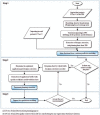Artificial neural network based gynaecological image-guided adaptive brachytherapy treatment planning correction of intra-fractional organs at risk dose variation
- PMID: 29441094
- PMCID: PMC5807998
- DOI: 10.5114/jcb.2017.72567
Artificial neural network based gynaecological image-guided adaptive brachytherapy treatment planning correction of intra-fractional organs at risk dose variation
Abstract
Purpose: Intra-fractional organs at risk (OARs) deformations can lead to dose variation during image-guided adaptive brachytherapy (IGABT). The aim of this study was to modify the final accepted brachytherapy treatment plan to dosimetrically compensate for these intra-fractional organs-applicators position variations and, at the same time, fulfilling the dosimetric criteria.
Material and methods: Thirty patients with locally advanced cervical cancer, after external beam radiotherapy (EBRT) of 45-50 Gy over five to six weeks with concomitant weekly chemotherapy, and qualified for intracavitary high-dose-rate (HDR) brachytherapy with tandem-ovoid applicators were selected for this study. Second computed tomography scan was done for each patient after finishing brachytherapy treatment with applicators in situ. Artificial neural networks (ANNs) based models were used to predict intra-fractional OARs dose-volume histogram parameters variations and propose a new final plan.
Results: A model was developed to estimate the intra-fractional organs dose variations during gynaecological intracavitary brachytherapy. Also, ANNs were used to modify the final brachytherapy treatment plan to compensate dosimetrically for changes in 'organs-applicators', while maintaining target dose at the original level.
Conclusions: There are semi-automatic and fast responding models that can be used in the routine clinical workflow to reduce individually IGABT uncertainties. These models can be more validated by more patients' plans to be able to serve as a clinical tool.
Keywords: ANN-based model; IGABT; cervical cancer; intra-fractional dose variations.
Figures





References
-
- ICRU/GEC-ESTRO report no. 89 Prescribing, Recording, and Reporting Brachytherapy for Cancer of the Cervix. International Commission on Radiation Units & Measurements, Inc..2016. - PubMed
-
- Haie-Meder C, Pötter R, Van Limbergen E, et al. Recommendations from Gynaecological (GYN) GEC-ESTRO Working Group (I): concepts and terms in 3D image based 3D treatment planning in cervix cancer brachytherapy with emphasis on MRI assessment of GTV and CTV. Radiother Oncol. 2005;74:235–245. - PubMed
-
- Pötter R, Haie-Meder C, Van Limbergen E, et al. Recommendations from gynaecological (GYN) GEC ESTRO working group (II): concepts and terms in 3D image-based treatment planning in cervix cancer brachytherapy-3D dose volume parameters and aspects of 3D image-based anatomy, radiation physics, radiobiology. Radiother Oncol. 2006;78:67–77. - PubMed
LinkOut - more resources
Full Text Sources
Other Literature Sources
